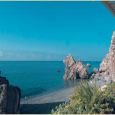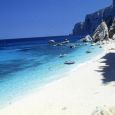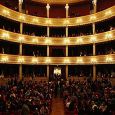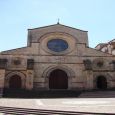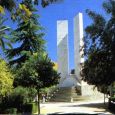Cosenza
Advertisement
By Air
The nearest airport is Lamezia Terme.It is about 77 km from Cosenza and is well connected by highway to the A3.Is currently in the process of designing the airport of Cosenza, Sybaris and will be built in addition to meeting the needs of the basin of the Ionian Cosentino, will be easily accessible from the urban area of Cosenza.
By Train
The Coseley Station is the airport terminal lines to Sybaris and Paola.It is managed by RFI, but it also stands line the narrow gauge of the Ferrovie della Calabria to Catanzaro.The Railways of Calabria have a metro rail service from Cosenza in Cosenza Screening Lise Casali.The station is a center of Cosenza stations of the metropolitan rail service of the Ferrovie della Calabria to serve the city.It lies on the line Cosenza - Catanzaro Lido of Ferrovie della Calabria.In the past, the station, whose yard was on the side track where there is now the entrance, was the airport terminal of the two lines, the beam track was located between the existing building and the Locomotive Depot of Cosenza of the FS, in its When placed in the middle of the station FCL and the old train station in Cosenza.
By Road
The urban area of Cosenza with regard to mobility and transport is a major transport nodes Calabria: in fact, converge on the 'Highway A3, SS 107, State Route 19 in Calabria, the SS 19 bis and two railway lines.These arteries of regional and national level result in a significant through traffic on the main Tyrrhenian and Ionian seas, which overlaps with the local flow of the conurbation of Cosenza.
Advertisement
Church of San Domenico
Founded in 1448, the church combines Renaissance and Medieval elements. Its most interesting feature is the rose window defined by 16 little tuff columns. The wooden portal (1614) is inlaid with floral motifs, figures of saints and coats of arms.Inside the church are works by the Cosentian painter A. Granata (late 18th century): Santa Rosa, Santa Caterina, San Ludovico, San Giacinto and San Domenico. The high altar is made of polychrome marble (1767). In the transept, there is a Deposition and a San Vincenzo Ferreri (late 18th century, anonymous). The sacristy is noted for its ribbed vault, a double lancet window with a narrow arch and a wooden choir installed in 1635.
Hohenstaufen Castle
was originally built by the Saracens on the ruins of the ancient Rocca Brutia, around the year 1000. The castle was restored by Frederick II, Holy Roman Emperor, adding the octagonal tower to the original structure, in 1239. According to tradition, his son Henry lived in this castle, as a prisoner at his father’s command.All signs of the ancient Saracen structure have now disappeared. In the internal cloister, the modifications made by the Bourbons in order to convert it into a prison can also be seen. The entrance-hall is covered by ogival arches with engraved brackets. A wide corridor is dominated by some fleur-de-lis from the House of Anjou coat of arms. They are engraved on the ribbed Hohenstaufen arches.
Open Air Museum
In the modern part of Cosenza, in an area stretching from the pedestrianized Corso Mazzini to Piazza Bilotti, lies the open-air "Museo MAB" (Museo all'aperto Bilotti). The museum hosts a wide range of modern art sculptures that stand in the street for residents and tourists. The sculptures were donated to the city by the Italian-American entrepreneur and art collector, Carlo Bilotti. They include Saint George and the Dragon by Salvador Dalí, Hector and Andromache by Giorgio de Chirico, "the Bronzes" by Sacha Sosno, The Bather by Emilio Greco, The Cardinal by Giacomo Manzù and various marble sculptures by Pietro Consagra.
Villa Vecchia
is a characteristic of the spaces of the city of Cosenza.It is a communal garden that extends in a rather large area in Piazza March 15, in the heart of the city (commonly called Old Cosenza from Cosenza).Located near the Prefecture, has several entrances.You can also access it from the space in front of the famous opera Alfonso Rendano, renovated in recent years.Inside the villa, which is spread over several floors, there are some statues, fountains and a circular area, which was originally intended to be an amphitheater.The green areas are characterized by hidden alleys, giving a special atmosphere at the Villa Vecchia, making it one of the most popular of Cosenza.During the year, some of the city's most important cultural events take place in the Villa Vecchia.Of these, the largest is probably the Feast of the invasion, during which intellectuals and artists from around the world come together based on a theme.In recent editions (that of July 2006 was postponed for a year because of an impasse administrative) Old Villa has hosted musicians such as Patti Smith and Lou Reed.
Norman-Swabian Castle
is a strong Pancrazio Hill on which stands the city itself.On 380 meters of Pancrazio Hill, at the bottom of the homonym street, the ruins of the castle dominate the town bruzio.Raised by the Saracens on the ruins of the Fortress Bretica perhaps, after 1000 AD and was rebuilt by the Arab Caliph Saati . Around 1130 the original structure was reinforced by the Norman Duke Roger II . Destroyed by an earthquake in 1184, Frederick II of Swabia took care of reconstruction to the 1239, according to a military project of its architects.Built by local labor with blocks of tufa limestone quarries of Mendicino and Laurignano, the castle was rectangular and at different levels, with two square towers and two polygonal corners.According to a tradition which is no longer followed, jailed in 1235 his son Frederick II Henry the lame man, guilty of collusion with the towns of northern Italy rebelled at the Emperor.
National Gallery of Cosenza
is located in the ancient Palazzo Arnone, located on Route Triglio, in GV Gravina Cosenza.The palace, started to build in the early sixteenth century by Bartolo Arnone, was sold to the state before its completion. It was the first seat of the Court and the Royal Audience, and eventually turned it into a prison.After the transfer of the prison, and a period of neglect, began work on the adaptation of the structure as a museum.There is a permanent placement art gallery with works by Peter Negroni, Mattia Preti, Luca Giordano and others, and is home to several high-profile exhibitions, including one dedicated to Umberto Boccioni ended December 31, 2009.The structure was reorganized in 2008, and March 2010 are accessible to all four rooms, the first of which houses a wooden shovel found in the palace at the time of its acquisition by the Italian state.Among these works by Mattia Preti, The Martyrdom of St. Sebastian, Hercules, Hercules and Prometheus free free Theseus.The last room housed two large paintings, about 5 x 3 m, by Luca Giordano.As of May 29, 2010 the National Gallery of Palazzo Arnone has been enriched by prestigious collection of 38 works Carime, for which was set up a new wing of the exhibition complex.There are important works by Mattia Preti, Luca Giordano, Ribera, and Gisella Boccioni.
Theater of Cosenza
is dedicated to the pianist Alfonso Rendano.Built by the city, the architect Zumpano, in 1887 was completed in 1909 and inaugurated on November 20 of that year with a performance of Aida by Giuseppe Verdi.Style neoclassical century, with three tiers of boxes, stood beautiful stucco and painted decorations, especially on the ceiling, painted by Cosentino Henry Salfi.In 1943 , a bomb aimed at the nearby Swabian castle, struck in the middle of the theater, destroying the roof and severely damaging all the furnishings.In the 2002 - in 2003 he was again restored and now boasts an exceptional artistic variety.
Information not available
Information not available
Advertisement

